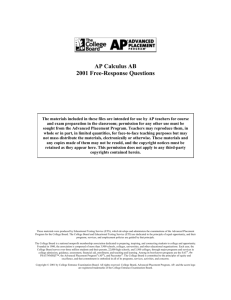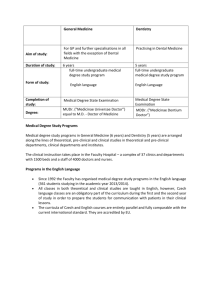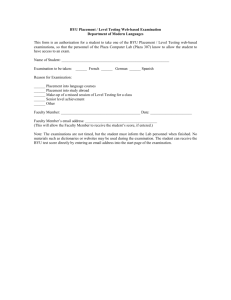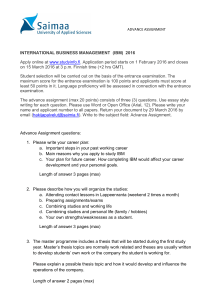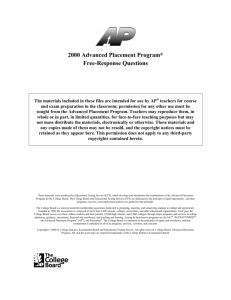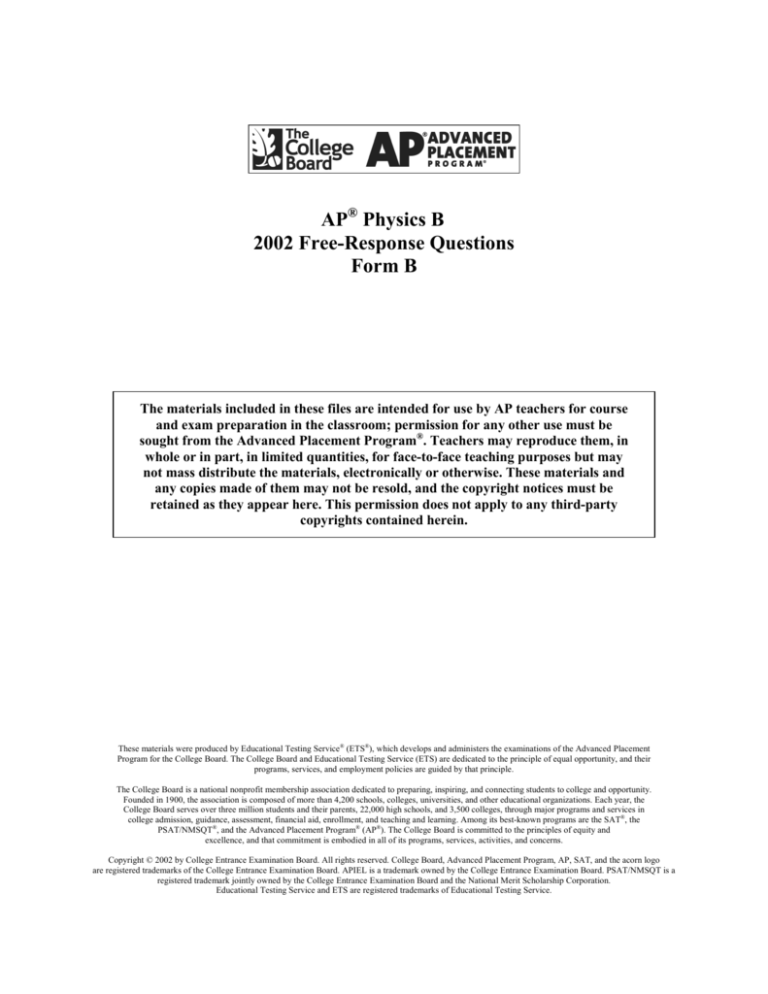
AP® Physics B
2002 Free-Response Questions
Form B
The materials included in these files are intended for use by AP teachers for course
and exam preparation in the classroom; permission for any other use must be
sought from the Advanced Placement Program®. Teachers may reproduce them, in
whole or in part, in limited quantities, for face-to-face teaching purposes but may
not mass distribute the materials, electronically or otherwise. These materials and
any copies made of them may not be resold, and the copyright notices must be
retained as they appear here. This permission does not apply to any third-party
copyrights contained herein.
These materials were produced by Educational Testing Service® (ETS®), which develops and administers the examinations of the Advanced Placement
Program for the College Board. The College Board and Educational Testing Service (ETS) are dedicated to the principle of equal opportunity, and their
programs, services, and employment policies are guided by that principle.
The College Board is a national nonprofit membership association dedicated to preparing, inspiring, and connecting students to college and opportunity.
Founded in 1900, the association is composed of more than 4,200 schools, colleges, universities, and other educational organizations. Each year, the
College Board serves over three million students and their parents, 22,000 high schools, and 3,500 colleges, through major programs and services in
college admission, guidance, assessment, financial aid, enrollment, and teaching and learning. Among its best-known programs are the SAT®, the
PSAT/NMSQT®, and the Advanced Placement Program® (AP®). The College Board is committed to the principles of equity and
excellence, and that commitment is embodied in all of its programs, services, activities, and concerns.
Copyright © 2002 by College Entrance Examination Board. All rights reserved. College Board, Advanced Placement Program, AP, SAT, and the acorn logo
are registered trademarks of the College Entrance Examination Board. APIEL is a trademark owned by the College Entrance Examination Board. PSAT/NMSQT is a
registered trademark jointly owned by the College Entrance Examination Board and the National Merit Scholarship Corporation.
Educational Testing Service and ETS are registered trademarks of Educational Testing Service.
TABLE OF INFORMATION FOR 2002
CONSTANTS AND CONVERSION FACTORS
1 unified atomic mass unit,
UNITS
1 u = 1.66 10
-27
= 931 MeV/c
Proton mass,
m p = 1.67 × 10 −27 kg
Neutron mass,
mn = 1.67 × 10 −27 kg
Electron mass,
Magnitude of the electron charge,
me = 9.11 × 10
e = 1.60 × 10
Symbol
meter
kilogram
Factor
Prefix
m
10 9
giga
G
kg
6
mega
M
kilo
k
centi
c
milli
m
micro
µ
nano
n
pico
p
second
s
ampere
kg
−19
Name
C
A
kelvin
Avogadro’s number,
N0 = 6.02 × 10 23 mol −1
Universal gas constant,
R = 8.31 J / ( mol ¼ K )
K
mole
mol
hertz
Hz
Boltzmann’s constant,
k B = 1.38 × 10 −23 J / K
Speed of light,
c = 3.00 × 10 8 m / s
newton
N
Planck’s constant,
h = 6.63 × 10 −34 J ⋅ s
pascal
Pa
= 4.14 × 10
−15
eV ⋅ s
hc = 1.99 × 10 −25 J ⋅ m
= 1.24 × 10 3 eV ⋅ nm
Vacuum permittivity,
Coulomb’s law constant,
Vacuum permeability,
Magnetic constant,
Universal gravitational constant,
Acceleration due to gravity
at the Earth’s surface,
1 atmosphere pressure,
⑀ 0 = 8.85 × 10
−12
C / N⋅m
2
k = 1 / 4π ⑀ 0 = 9.0 × 10 N ⋅ m / C
9
2
2
2
µ 0 = 4π × 10 −7 (T ⋅ m ) / A
k = µ 0 / 4π = 10 (T ⋅ m ) / A
−7
G
= 6.67 10 -11 m 3 / kg ¼ s 2
g = 9.8 m / s
2
1 atm = 1.0 × 10 5 N / m 2
= 1.0 × 10 5 Pa
1 electron volt,
Symbol
kg
2
−31
PREFIXES
1 eV = 1.60 × 10 −19 J
10
10 3
10
10
10
−2
−3
−6
10 −9
10
−12
VALUES OF TRIGONOMETRIC FUNCTIONS
FOR COMMON ANGLES
joule
J
watt
W
θ
coulomb
C
0
o
volt
V
ohm
Ω
henry
H
farad
F
tesla
T
45o
sin θ
cos θ
tan θ
0
1
0
3 /2
3 /3
30o
1/2
37o
3/5
degree
Celsius
o
C
53o
electronvolt
eV
60o
90o
2 /2
4/5
4/5
2 /2
3/4
1
3/5
4/3
3 /2
1/2
3
1
0
∞
The following conventions are used in this examination.
I. Unless otherwise stated, the frame of reference of any problem is assumed to be inertial.
II. The direction of any electric current is the direction of flow of positive charge (conventional current).
III. For any isolated electric charge, the electric potential is defined as zero at an infinite distance from the charge.
IV. For mechanics and thermodynamics equations, W represents the work done on a system.
2
ADVANCED PLACEMENT PHYSICS B EQUATIONS FOR 2002
NEWTONIAN MECHANICS
u = u 0 + at
1 2
at
2
x = x0 + u0 t +
0
u 2 = u 0 2 + 2a x - x 0
5
Ê F = Fnet = ma
F fric mN
ac =
u2
r
t = rF sin q
p = mv
J = FDt =
Dp
1
mu 2
2
K =
DUg = mgh
W = F ⴢ Dr = FDr cos q
Pavg =
W
Dt
P = F ⴢ v = Fu cos q
Fs = - k x
1 2
kx
2
Us =
m
Ts = 2 p
k
Tp = 2 p
T =
1
f
FG = UG
l
g
a =
F =
f =
h =
J =
K =
k =
l =
m=
N =
P =
p =
r =
r =
T =
t =
U=
u =
W=
x =
m=
q =
t =
acceleration
force
frequency
height
impulse
kinetic energy
spring constant
length
mass
normal force
power
momentum
radius or distance
position vector
period
time
potential energy
velocity or speed
work done on a system
position
coefficient of friction
angle
torque
ELECTRICITY AND MAGNETISM
F=
1 q1 q 2
4 p⑀ 0 r 2
E=
F
q
UE = qV =
E avg = −
V=
r2
Gm1m2
= r
1 q1 q 2
4 p⑀ 0 r
V
d
qi
1
4 p⑀ 0
∑r
i
i
Q
V
⑀ A
C= 0
d
1
1
Uc = QV = CV 2
2
2
C=
I avg =
DQ
Dt
ρl
A
V = IR
P = IV
R=
C p = ∑ Ci
i
1
1
=∑
Cs
i Ci
Rs = ∑ Ri
i
1
1
=∑
Rp
i Ri
FB = qu B sin θ
FB = BIl sin θ
B=
Gm1m2
A
B
C
d
E
m0 I
2p r
fm = B • A = BA cos θ
eavg = −
e = Blu
3
Dfm
Dt
=
=
=
=
=
=
=
=
=
=
=
=
=
=
=
=
=
area
magnetic field
capacitance
distance
electric field
e emf
F
force
I
current
l
length
P
power
Q charge
q
point charge
R
resistance
r
distance
t
time
U potential (stored) energy
V
electric potential or
potential difference
u = velocity or speed
r = resistivity
fm = magnetic flux
ADVANCED PLACEMENT PHYSICS B EQUATIONS FOR 2002
FLUID MECHANICS AND
WAVES AND OPTICS
THERMAL PHYSICS
p = p0 + rgh
Fbuoy = rVg
A1u1 = A2 u 2
1
p + rgy + ru 2 = const.
2
D l = a l 0 DT
Q = mL
Q = mcDT
p =
F
A
pV = nRT
3
k T
2 B
K avg =
3 RT
=
M
u rms =
W = - pDV
Q = ncDT
DU = Q + W
DU = ncV DT
e =
ec =
3k B T
m
A = area
c = specific heat or molar
specific heat
e = efficiency
F = force
h = depth
Kavg = average molecular
kinetic energy
L = heat of transformation
l = length
M = molecular mass
m = mass of sample
n = number of moles
p = pressure
Q = heat transferred to a system
T = temperature
U = internal energy
V = volume
u = velocity or speed
urms = root-mean-square
velocity
W = work done on a system
y = height
a = coefficient of linear
expansion
µ = mass of molecule
r = density
W
QH
TH - TC
TH
ATOMIC AND NUCLEAR PHYSICS
E = hf = pc
Kmax = hf − f
l =
h
p
DE = ( Dm) c 2
E
f
K
m
p
l
f
=
=
=
=
=
=
=
energy
frequency
kinetic energy
mass
momentum
wavelength
work function
4
u = fl
c
n =
u
n 1 sin q1 = n 2 sin q 2
sin q c =
n2
n1
1
1
1
+
=
si
s0
f
h
s
M = i = - i
s0
h0
R
2
d sin q = ml
f =
xm ⬇
d = separation
f = frequency or focal
length
h = height
L = distance
M = magnification
m = an integer
n = index of refraction
R = radius of curvature
s = distance
u = speed
x = position
l = wavelength
q = angle
ml L
d
GEOMETRY AND TRIGONOMETRY
Rectangle
A = bh
Triangle
1
A = bh
2
Circle
A = pr 2
C = 2 pr
Parallelepiped
V = lwh
Cylinder
V = pr 2 l
S = 2 pr l + 2 pr 2
Sphere
4
V = pr 3
3
S = 4 pr 2
Right Triangle
a 2 + b2 = c2
a
sin q =
c
b
cos q = c
a
tan q = b
A=
C=
V=
S =
b =
h =
l =
w=
r =
area
circumference
volume
surface area
base
height
length
width
radius
c
a
90
q
b
2002 AP® PHYSICS B FREE-RESPONSE QUESTIONS (Form B)
PHYSICS B
SECTION II
Time—90 minutes
7 Questions
Directions: Answer all seven questions, which are weighted according to the points indicated. The suggested time
is about 15 minutes for answering each of questions 1-4, and about 10 minutes for answering each of questions 5-7.
The parts within a question may not have equal weight. Show all your work in the goldenrod booklet in the spaces
provided after each part, NOT in this lavender insert.
1. (15 points)
A 2.0 kg frictionless cart is moving at a constant speed of 3.0 m/s to the right on a horizontal surface, as shown
above, when it collides with a second cart of undetermined mass m that is initially at rest. The force F of the
collision as a function of time t is shown in the graph below, where t = 0 is the instant of initial contact. As a
result of the collision, the second cart acquires a speed of 1.6 m/s to the right. Assume that friction is negligible
before, during, and after the collision.
(a) Calculate the magnitude and direction of the velocity of the 2.0 kg cart after the collision.
(b) Calculate the mass m of the second cart.
Copyright © 2002 by College Entrance Examination Board. All rights reserved.
Advanced Placement Program and AP are registered trademarks of the College Entrance Examination Board.
GO ON TO THE NEXT PAGE.
5
2002 AP® PHYSICS B FREE-RESPONSE QUESTIONS (Form B)
After the collision, the second cart eventually experiences a ramp, which it traverses with no frictional losses.
The graph below shows the speed u of the second cart as a function of time t for the next 5.0 s, where t = 0 is
now the instant at which the carts separate.
(c) Calculate the acceleration of the cart at t = 3.0 s.
(d) Calculate the distance traveled by the second cart during the 5.0 s interval after the collision (0 s < t < 5.0 s).
(e) State whether the ramp goes up or down and calculate the maximum elevation (above or below the initial
height) reached by the second cart on the ramp during the 5.0 s interval after the collision (0 s < t < 5.0 s).
Copyright © 2002 by College Entrance Examination Board. All rights reserved.
Advanced Placement Program and AP are registered trademarks of the College Entrance Examination Board.
GO ON TO THE NEXT PAGE.
6
2002 AP® PHYSICS B FREE-RESPONSE QUESTIONS (Form B)
2. (15 points)
A ball attached to a string of length l swings in a horizontal circle, as shown above, with a constant speed. The
string makes an angle q with the vertical, and T is the magnitude of the tension in the string. Express your
answers to the following in terms of the given quantities and fundamental constants.
(a) On the figure below, draw and label vectors to represent all the forces acting on the ball when it is at the
position shown in the diagram. The lengths of the vectors should be consistent with the relative magnitudes
of the forces.
(b) Determine the mass of the ball.
(c) Determine the speed of the ball.
(d) Determine the frequency of revolution of the ball.
(e) Suppose that the string breaks as the ball swings in its circular path. Qualitatively describe the trajectory of
the ball after the string breaks but before it hits the ground.
Copyright © 2002 by College Entrance Examination Board. All rights reserved.
Advanced Placement Program and AP are registered trademarks of the College Entrance Examination Board.
GO ON TO THE NEXT PAGE.
7
2002 AP® PHYSICS B FREE-RESPONSE QUESTIONS (Form B)
3. (15 points)
Lightbulbs of fixed resistance 3.0 W and 6.0 W, a 9.0 V battery, and a switch S are connected as shown in the
schematic diagram above. The switch S is closed.
(a) Calculate the current in bulb A.
(b) Which lightbulb is brightest? Justify your answer.
(c) Switch S is then opened. By checking the appropriate spaces below, indicate whether the brightness of each
lightbulb increases, decreases, or remains the same. Explain your reasoning for each lightbulb.
i. Bulb A: The brightness
___ increases
___ decreases
___ remains the same
___ increases
___ decreases
___ remains the same
___ increases
___ decreases
___ remains the same
Explanation:
ii. Bulb B: The brightness
Explanation:
iii. Bulb C: The brightness
Explanation:
Copyright © 2002 by College Entrance Examination Board. All rights reserved.
Advanced Placement Program and AP are registered trademarks of the College Entrance Examination Board.
GO ON TO THE NEXT PAGE.
8
2002 AP® PHYSICS B FREE-RESPONSE QUESTIONS (Form B)
4. (15 points)
A marine archaeologist looks out the port of a research submarine, as shown above. The port is spherically
shaped with center of curvature at point C and radius of curvature r. It is made of a material that has an index of
refraction of nw , the same as the index of refraction of seawater, which is greater than na , the index of
refraction of air. The archaeologist is located to the left of point C and some equipment in the submarine is
located behind the archaeologist. The archaeologist can see through the port, but the port also acts as a mirror so
the archaeologist can see the reflection of the equipment.
(a) What is the focal length of the mirror?
(b) On the following figure, sketch a ray diagram to locate the position of the image of the equipment formed as
a result of the mirror effect.
Copyright © 2002 by College Entrance Examination Board. All rights reserved.
Advanced Placement Program and AP are registered trademarks of the College Entrance Examination Board.
GO ON TO THE NEXT PAGE.
9
2002 AP® PHYSICS B FREE-RESPONSE QUESTIONS (Form B)
(c) Based on your ray diagram, check the appropriate spaces below to describe the image of the equipment
formed as a result of the mirror effect.
i. Image is: ___ upright
___ inverted
ii. Image is: ___ real
___ virtual
iii. Image is: ___ larger than the equipment
___ smaller than the equipment
The archaeologist also observes a seahorse located outside the port directly in front of the archeologist. Due to
refraction of light at the inner surface of the port, the seahorse does not appear to the archaeologist to be at its
actual location.
(d) On the following figure, sketch a ray diagram to locate the position of the image of the seahorse formed by
the refraction of light at the port.
(e) Based on your ray diagram, check the appropriate spaces below to describe the image of the seahorse, as
seen by the archaeologist, formed by the refraction of light at the port.
i. Image is: ___ upright
___ inverted
ii. Image is: ___ real
___ virtual
iii. Image is: ___ larger than the seahorse
___ smaller than the seahorse
Copyright © 2002 by College Entrance Examination Board. All rights reserved.
Advanced Placement Program and AP are registered trademarks of the College Entrance Examination Board.
GO ON TO THE NEXT PAGE.
10
2002 AP® PHYSICS B FREE-RESPONSE QUESTIONS (Form B)
5. (10 points)
Two parallel conducting plates, each of area 0.30 m 2 , are separated by a distance of 2.0 × 10 -2 m of air. One
plate has charge +Q; the other has charge -Q. An electric field of 5000 N/C is directed to the left in the space
between the plates, as shown in the diagram above.
(a) Indicate on the diagram which plate is positive (+) and which is negative (-).
(b) Determine the potential difference between the plates.
(c) Determine the capacitance of this arrangement of plates.
An electron is initially located at a point midway between the plates.
(d) Determine the magnitude of the electrostatic force on the electron at this location and state its direction.
(e) If the electron is released from rest at this location midway between the plates, determine its speed just
before striking one of the plates. Assume that gravitational effects are negligible.
Copyright © 2002 by College Entrance Examination Board. All rights reserved.
Advanced Placement Program and AP are registered trademarks of the College Entrance Examination Board.
GO ON TO THE NEXT PAGE.
11
2002 AP® PHYSICS B FREE-RESPONSE QUESTIONS (Form B)
6. (10 points)
A sealed steel canister is being used to store neon gas (atomic mass = 20.2 u). The mass of the steel canister
alone is 12.0 kg, and it has an interior volume of 8.00 liters = 8.00 10 -3 m 3 . There are 4.50 moles of neon
gas in the canister, and the temperature of the entire system is 300 K.
Reference information:
Specific heat of steel = 448 J kg -1 K -1
Specific heat of neon = 12.5 J mole -1 K -1
Specific heat of water = 4186 J kg -1 K -1
Heat of fusion of water = 3.33 10 5 J kg -1
Density of water = 1.00 10 3 kg m -3
Density of ice = 0.917 10 3 kg m -3
(a) Determine the pressure within the cylinder.
The sealed cylinder is now placed in a large tank containing a mixture of ice and water at 273 K. You may
neglect any change in the volume of the cylinder.
(b) Determine the pressure of the neon gas after the cylinder and its contents have reached thermal equilibrium
with the ice-water mixture.
(c) Determine the mass of the ice that melts during the equilibration of the cylinder.
Copyright © 2002 by College Entrance Examination Board. All rights reserved.
Advanced Placement Program and AP are registered trademarks of the College Entrance Examination Board.
GO ON TO THE NEXT PAGE.
12
2002 AP® PHYSICS B FREE-RESPONSE QUESTIONS (Form B)
7. (10 points)
An experimenter determines that when a beam of monoenergetic electrons bombards a sample of a pure gas,
atoms of the gas are excited if the kinetic energy of each electron in the beam is 3.70 eV or greater.
(a) Determine the deBroglie wavelength of 3.70 eV electrons.
(b) Once the gas is excited by 3.70 eV electrons, it emits monochromatic light. Determine the wavelength of
this light.
Experiments reveal that two additional wavelengths are emitted if the beam energy is raised to at least 4.90 eV.
(c) In the space below construct an energy-level diagram consistent with this information and determine the
energies of the photons associated with those two additional wavelengths.
END OF EXAMINATION
Copyright © 2002 by College Entrance Examination Board. All rights reserved.
Advanced Placement Program and AP are registered trademarks of the College Entrance Examination Board.
13


